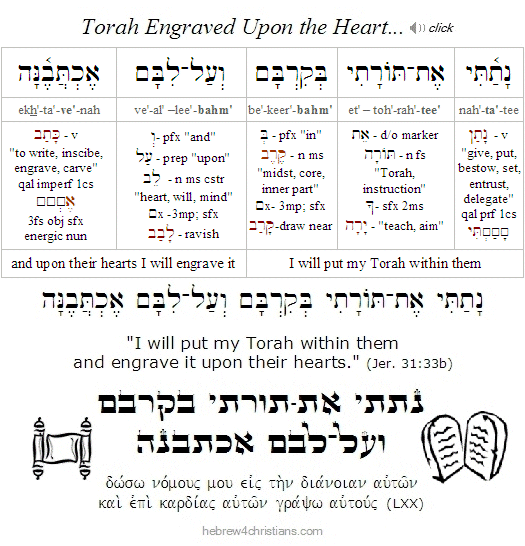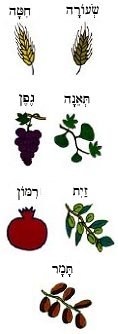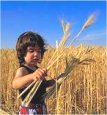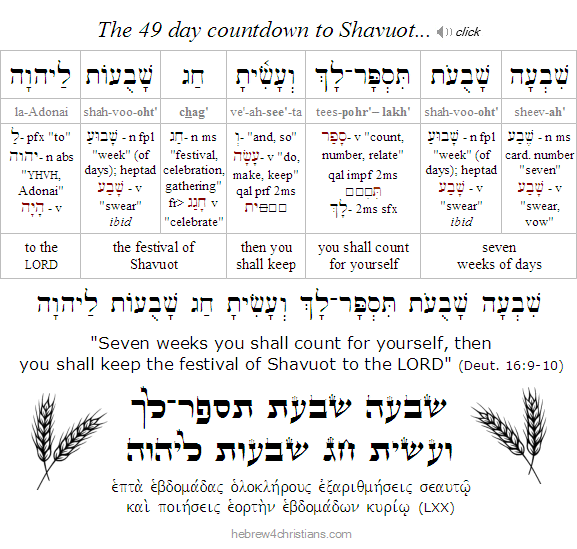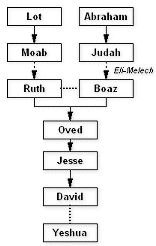|
|
 |
 |
 |
|
Shavuot - Weeks
|
|
|
|
Revelation and the Fruit of the Spirit
|
|
|
|
 |
 |
 |
|
The Revelation of Torah...
|
|
|
|
The festival of Shavuot ("Weeks, "Pentecost"") marks the culmination of the redemption, sometimes called Atzeret Pesach (עצרת פסח), or "the Gathering rally of Passover." Since the Exodus from Egypt was intended to lead to the revelation of Sinai, the goal of Passover is the giving of the Torah to the Jewish people. God took the Jews out of Egypt so that they would be His own treasured people, holy and separated from the pagan cultures around them. Indeed, all of the holidays are connected with this event, including the fall festivals of Rosh Hashanah, Yom Kippur and Sukkot.
|
|
|
 |
 |
|
According to the sages: The new moon of Nisan (חודש ניסן) marks the start of sacred time, Passover remembers the sacrifice of the Passover Lamb, the first day of Unleavened Bread remembers the Exodus from Egypt, the seventh day of Unleavened Bread remembers the crossing of the Red Sea, the counting of the Omer recalls the days before the giving of the Torah at Sinai, and Shavuot remembers the giving of the Torah exactly seven weeks (שבעה שבועות) after the Exodus (on Sivan 6). Indeed, Shavuot at Mount Sinai is sometimes considered the day on which Judaism was born.
|
 |
 |
|
The book of Exodus tells us how Moses was sent by God to Egypt to be a deliverer of Israel. Pharaoh, of course, did not heed Moses' appeal to set the people of Israel free from their slavery, and the stage was then set for the showdown between the God of Israel and the gods of Egypt.
After repeated demonstrations of the glory and power of the LORD, God told Moses that He would bring a final and terrible plague that would cause Pharaoh to relent and let the people go. All the firstborn sons in the land would be killed -- except for those who observed what God called the Passover.
The LORD commanded that on Nisan 10 the head of each household would select an unblemished young male lamb to be offered as a sacrifice to the LORD. On the afternoon of Nisan 14 (erev Pesach), a family member was to slaughter the lamb (called korban pesach) and smear some of its blood on all three sides of the doorframe, top, right and left. The lamb was then to be roasted and eaten with unleavened bread (i.e., matzah) and maror (bitter herbs). This meal was to be consumed "in haste" since the Israelites would begin their exodus the following morning (Nisan 15). The LORD further required that only matzah was to be eaten for a week after the Passover meal (from Nisan 15-22), perhaps to recall the haste in which they left Egypt.
At midnight on Nisan 15 the LORD killed all the firstborn males of those who did not put the blood of the lamb upon their doorposts (the Jews who trusted in the LORD were "passed over" (pasach) from the angel of death). Pharaoh and most of Egypt arose in the middle of the night, lamented the loss of their children, and begged the Israelites to leave Egypt. The great Exodus from Egypt finally began! After exactly 430 years in Egypt (Exod. 12:40-1, 51, but reckoned from the birth of Isaac) over 600,000 adult males, along with their wives and children, departed with a wealth of gold and silver which the Egyptians had given them.
As soon as the Jews left Egypt, a fiery Pillar of Cloud appeared before them, leading them from Rameses to Succoth and then southward toward the desert (Exod. 13:20-1). But Pharaoh and his army soon realized that the Jews were never coming back and decided to pursue and enslave them once again (Exod. 14:4). Six days later, on Nisan 21, the Israelites were trapped with the Egyptian army behind them and the Sea of Reeds before them. The Pillar of Cloud moved behind the Israelites and stood between them and the Egyptians. Moses then stretched out his staff before the sea and it miraculously parted so that the Jews could walk through. When the Jews had fully crossed over, the Egyptians tried to follow after them, but Moses again stretched out his staff and the waters caved in on them so that the pursuing army was drowned.
Three days later, on Nisan 24, the people came to Marah, where the water was bitter. Moses threw some wood in the waters and they became mayim chayim - sweet water good for drinking (Exod. 15:22-26). A month later, the Jews complained that they were out of food, but God sent manna to feed them (Exod. 16). Interestingly, the amount of manna collected each day was called an omer. Later still, the Jews began to settle at Rephidim, near Mount Sinai, but again there was no water. Moses was commanded to take the elders to a rock at Sinai and strike it with his staff to miraculously bring forth water (Exod. 17:1-7). While the Jews were camped in Rephidim, the Amalekites (descendants of Esau) suddenly attacked them. Israel won the battle, but God commanded them to never forget their adversaries (Exod. 17:9-16).
After 45 days in the desert, on the new moon of Sivan, the Jews reached the desert of Sinai and camped near the very mountain where Moses was first commissioned (Exod. 19:1). During the previous weeks the Jews had become more and more conscious of the LORD and therefore more and more readied to receive instruction (Torah) from Him before entering the Promised Land.
Moses ascended the mountain, and there God commanded him to tell the leaders that if they would obey the LORD and keep His covenant, then they would be the LORD's "kingdom of priests" and "holy nation." After delivering this message, the people responded by proclaiming, kol asher diber Adonai na'aseh ("all that the LORD has spoken, we shall do"). Moses then returned to the mountain and was told to command the people to sanctify themselves before the LORD descended upon the mountain in three days. The people were to abstain from worldly comforts and not so much as touch (under penalty of death) the boundaries of the mountain. "Be ready for the third day; for on the third day the LORD will come down on Mount Sinai in the sight of all the people."
Rabbinic tradition says that the Torah was actually given on the sixth of Sivan, the Shabbat following the new moon of Sivan that year (which would make the new moon of Sivan a Monday [Shabbat 86b]).
On Shabbat morning of the sixth of Sivan, exactly seven weeks after the Exodus, all the children of Israel gathered at the foot of Mount Sinai, where the LORD descended amidst thunder, lightning, billowing smoke, fire, and the voluminous blast of the shofar. The LORD then declared the foundation of moral conduct required of the people, the Ten Commandments.
The sound of a shofar grew louder and louder until terror gripped the heart of the people. The LORD then uttered, "I am the LORD Thy God who took you out of Egypt." As the LORD began speaking the second commandment, however, the people began falling back in fear and begged Moses to be their "middleman" or mediator before God. The people then stood far off, while Moses alone drew near to the thick darkness where God was.
As mediator of the covenant, Moses later reported to the Israelites all the words of the LORD and the people responded in unison, kol hadevarim asher diber Adonai na'eseh: "all the words which the LORD has said we will do." He wrote down the words of the covenant (sefer habrit), built an altar at the foot of Mount Sinai with twelve pillars (one for each tribe of Israel), and ordered sacrifices to the LORD to be made. He took the sacrificial blood from the offerings, threw half upon the altar, and read the covenant to the people. The people ratified the covenant with the words kol asher diber Adonai na'aseh v'nishma ("all that the LORD says we will do and obey"). Upon hearing their ratification, Moses took the other half of the sacrificial blood and threw it on the people saying, "Behold the blood of the covenant that the LORD has made with you in accordance with all these words."
Next, Moses, Aaron (and his sons Nadav and Avihu), and seventy of the elders of Israel ascended Mount Sinai to eat a "covenant affirmation meal" between klal Yisrael and the LORD. It was there that the elders beheld the awesome glory of Elohei Yisrael (the God of Israel), under whose feet was "a pavement of sapphires, like the very heaven for clearness" (Exod. 24:9-11).
After returning from the mountain with the elders, the LORD commanded Moses to go back up to receive luchot ha'even (the tablets of stone) inscribed with the Ten Commandments (Exod. 24:12). He remained on the mountain for a total of 40 days and 40 nights learning Torah while the Israelites waited for him at the camp down below (Exod. 24:13-18).
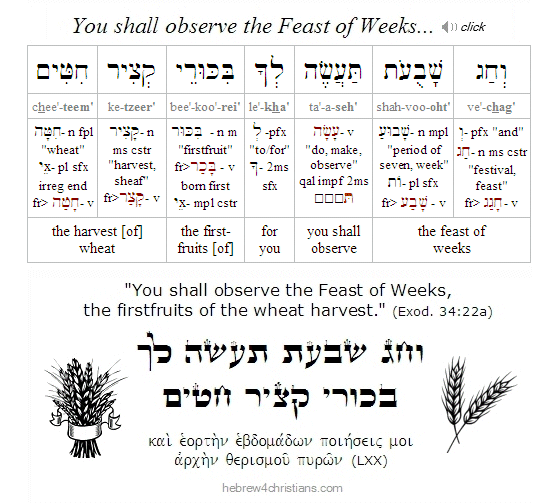 |
|
 |
 |
|
Midrashrim about the Tablets
|
 |
 |
|
According to Jewish midrash, the tablets of stone were made of blue sapphire as a symbol of the heavens and God's throne, written by the "finger of God" (Exod. 31:18). The Hebrew letters were said to be bored fully through the stone (Exod. 32:15), which was a miracle, since the inner part of some of the Hebrew letters (such as Samekh and the final Mem) "floated" in place. Moreover, even though the letters were bored fully through the stone, both sides appeared normally (that is, the "back" of the tablet looked identical to the front - Shabbos 104a).
|
|
|
 |
 |
|
Jewish tradition claims that the Hebrew script used was Ketav Ashurit (the classical Hebrew script used in the Scriptures today), and not the older Ketav Ivri (which was later written (by God) on the second set of tablets that Moses hewed after he broke the original set). Another midrash says that the tablets "carried their own weight," enabling Moses to carry them down the mountain.
Another well-known Jewish midrash says that the LORD initially offered the Torah to each of the 70 nations, but none accepted it without first asking what it was about. After hearing the various commandments, each nation had some excuse or another for not accepting it (for example, God offered Torah to the Ishmaelites, but they declined the offer because of its prohibition of theft, since their trading practices required it). God finally turned to the nation of Israel, who said kol asher diber Adonai na'aseh ("all that the LORD says we will do"). Note something remarkable here: Unlike the other nations, Israel chose Torah before knowing its contents: na'aseh ve'nishma (Exod. 19:8). In fact, even after Moses had explained the extent of Torah's demands, all Israel said kol asher diber Adonai na'aseh ve'nishma ("all that the LORD says we will do and obey") (Exod. 24:7). The heart of the Jew unquestioningly says "Yes" to the LORD like a child who trusts his loving father... (halevai - may we all so live!).
|
 |
 |
|
The Agricultural background - Yom Ha-Bikkurim
|
 |
 |
|
When the Jews began to settle in the Promised Land, the meaning of Shavuot was transformed into an agricultural holiday that celebrated the LORD's provision for His people. In the final book of Torah, Moses reviewed the history and the laws given to the Jews and reminded them to faithfully observe Passover (Deut. 16:1-7), Unleavened Bread (Deut 16:8), the Omer Count (Deut 16:9), and Shavuot:
You shall count seven weeks. Begin to count the seven weeks from the time the sickle is first put to the standing grain. Then you shall keep the Feast of Weeks to the LORD your God with the tribute of a freewill offering from your hand, which you shall give as the LORD your God blesses you. And you shall rejoice before the LORD your God. (Deut. 16:9-11)
|
 |
 |
|
The Hebrew word sheva means seven, shavu'ah means week, and shavu'ot means weeks. Exactly seven weeks after the first harvest of barley is the celebration of Shavuot ("weeks"), one of the three pilgrimage holidays where Jews would come to the mishkan (and later the Temple) to present the firstfruits of their spring crops before the LORD. Since Shavuot occurs on the 50th day after Passover, the Greek translators of the Torah called this day "Pentecost."
|
 |
 |
|
The first fruits of the crops were called bikkurim, and referred especially to Shivat Ha'minim (שִׁבְעַת הַמִּינִים), the seven species of fruits of the Promised Land: Wheat, barley, grapes, figs, pomegranates, olives, and dates (Deut. 8:8). As soon as a Jewish farmer saw the first sign of ripening fruit in his field or orchard, he would tie a string or ribbon around it and designate it as bikkurim.
Later he would pick this fruit, put it in a basket woven of gold and silver (the poor used wicker baskets of peeled willow branches) and set off for the mishkan (or later to the Temple in Jerusalem) for the festival of Shavuot. Since it was a pilgrimage festival, a large procession of other Jews would be carrying their baskets on the road, singing songs of joyful praise. They would place their baskets on oxen adorned with garlands of flowers in a grand parade to Jerusalem! As the pilgrims passed through various towns along the way, they would be accompanied by still others (Deut. 26:1-3).
At the mishkan (or Temple), each family would present the basket of fruits to a kohen (priest) to be put before the altar while reciting the following passage from the book of Deuteronomy:
|
|
|
 |
 |
|
A wandering Aramean was my father. And he went down into Egypt and sojourned there, few in number, and there he became a nation, great, mighty, and populous. And the Egyptians treated us harshly and humiliated us and laid on us hard labor. Then we cried to the LORD, the God of our fathers, and the LORD heard our voice and saw our affliction, our toil, and our oppression. And the LORD brought us out of Egypt with a mighty hand and an outstretched arm, with great deeds of terror, with signs and wonders. And he brought us into this place and gave us this land, a land flowing with milk and honey. And behold, now I bring the first of the fruit of the ground, which you, O LORD, have given me.' And you shall set it down before the LORD your God and worship before the LORD your God. (26:5-11)
|
 |
 |
|
The Priestly Avodah - Shtei Ha-Lechem
|
 |
 |
|
In the priestly avodah (service) at the mishkan (and later at the Temple), the 49 day countdown to the holiday is called Sefirat Omer ("Counting of the Omer"), every day of which a special blessing was recited naming exactly how many more days were left before the climactic 50th day - a Jubilee of days!
Just as a sample of the first crop of barley was waved before the altar during the festival of Firstfruits, so on Shavu'ot a sample of the first crop of the wheat harvest was brought to the priests, baked into two loaves of leavened bread (shtei halechem), and then waved (tenufah) before the altar as a concluding rite of the season. This was the only time leavened bread was used by the priests for the avodah (see Lev. 2:11).
|
 |
|
|
 |
 |
 |
|
Shavuot stands in contrast to Passover that requires unleavened bread (matzah), since the two loaves of bread made from the first fruit of the wheat harvest were baked with chametz (yeast) before being "waved before the LORD" (Lev. 23:15-20). There is some uncertainty among Jewish sages regarding the meaning of the use of the otherwise forbidden leaven (Lev. 2:11), though prophetically it is a picture of the "one new man" (composed of both Jew and Gentile) before the altar of the LORD (Eph. 2:14).
|
|
|
 |
 |
|
While the Temple was still standing, Shavuot (along with Passover and Sukkot), was one of the three pilgrim holidays (shalosh regalim) when Jews would come to Jerusalem to make a sacrifice of their crop's first fruits. After the Temple was destroyed in A.D. 70, the agricultural aspect of Shavuot could no longer be observed, and the Talmudic sages later re-connected this festival with the giving of the Torah at Mt. Sinai during the month of Sivan (Exod. 19:1).
|
|
 |
 |
|
Shavuot thus came to be called Z'man mattan torateinu - "The Season of the Giving of the Torah." To this day, it has become customary to observe Shavuot by staying up all night studying Torah. While this custom (called tikkun leil shavu'ot) is beautiful, Jewish law prohibits afflicting or torturing oneself on a holiday, so if you are tired or won't feel well the next day, it is better to go to sleep). A tikkun (order) presents small excerpts from each book of the Tanakh as well as tractates from the Talmud (see below).
|
 |
 |
|
Timeline of Giving the Torah
|
 |
 |
|
There is a connection between Passover, the Omer Count, and the holiday of Shavuot that is rooted in the redemptive actions of the LORD God of Israel. According to various Jewish sources, the basic timeline for the giving of the Torah at Sinai is as follows:
- Nisan 1 - The Start of the Sacred Year
On the first of Nisan, two weeks before the Exodus, the LORD showed Moses the new moon and commenced the divine lunar calendar. This is called Rosh Chodashim.
- Nisan 15 - Passover
Two weeks later, on a Thursday, God was ready to deliver the Israelites from their bondage in Egypt. Earlier that evening the Israelites kept the Passover Seder and sprinkled the blood of the lamb on their doorposts. At the stroke of midnight of Nisan 15 the LORD sent the last of the ten plagues on the Egyptians, killing all their firstborn.This was the breaking point for Pharaoh and Israel was "permitted" to leave Egypt. 600,000 adult males (plus the woman and children and a "mixed multitude") left Egypt and began the journey to Sinai under the leadership of Moses.
- Nisan 18 - Pharaoh Pursues
Three days after the Exodus, and regardless of the plagues and devastation that befell Egypt, Pharaoh mobilized his army and pursued the Jews to bring them back. Perhaps this was the result of Pharoah realizing that the "three-day feast to the LORD" in the wilderness was a permanent escape from his clutches....
- Nisan 20 - Pharaoh traps the Israelites
Pharaoh's army trapped the Jewish people against the Sea of Reeds. The Shekhinah Glory of the LORD intervened and blocked them from attack.
- Nisan 21 - the parting of the Sea
The following day the LORD commanded Moses to order the Israelites to march directly into the waters of the sea. Nachshon ben Aminadav of the tribe of Judah was the first to jump into the sea; the water split, and "the children of Israel walked across on the dry land in the midst of the sea." When the Egyptians attempted to follow after them, the waters rushed back and drowned them. The Israelites celebrated their deliverance with the "Song at the Sea" in praise to the LORD.
- Nisan 24 - the first Shabbat celebrated
Two days later the Israelites arrived in Marah where they received the commandment to observe Shabbat.
- Iyyar 15 - Manna is given
One month after the Exodus, God provided bread from heaven (manna) which sustained the Israelites during their years of wandering through the desert. In light of the divine provision of food, the commandment not to collect manna on Shabbat is restated (on Iyyar 22).
- Iyyar 23 - Water from the Rock
38 days after the Exodus the Israelites arrived at Rephidim, a desert area. The people complained that they would die of thirst but the LORD commanded Moses to strike a rock with his staff to produce water.
- Sivan 1 - Arrival at Sinai
The Israelites finally arrived at the desert of Sinai (Exod. 19:1) where Moses was initially commissioned. Note that the question of whether the new moon of Sivan (Rosh Chodesh Sivan) fell on Sunday or Monday is undecided (Talmud, Shabbat 86b).
- Sivan 2 - The Day of Distinction, "Yom HaMeyuchas"
On this day Moses ascended Mount Sinai and God told him to tell the people of Israel: "You shall be to Me a kingdom of priests and a holy nation" (Exodus 19:2-7).
- Sivan 3-5 - the three days of preparation
On Sivan 3 the LORD instructed Moses to "set boundaries" (hagbalah) for the people around the mountain in preparation for the giving of the Torah three days later (Exod. 19:9-15).
- Sivan 4 - Moses writes the Torah
According to midrash, on Sivan 4 Moses wrote down the first 68 chapters of the Torah, from Genesis 1:1 to the account of the giving of the Torah in Exodus 19. This is obviously unlikely, but it is part of Jewish tradition, nonetheless.
- Sivan 5 - the Covenant offered
On Sivan 5 Moses made a covenant with the Jewish people at the foot of Mount Sinai at which the people declared, "All that the LORD has spoken, we shall do and hear" (Exod. 19:8; cp. Exod. 24:7).
- Sivan 6 - The giving of the Torah
On the 6th Sivan, exactly seven weeks after the Exodus, the LORD revealed Himself on Mount Sinai. All of Israel (600,000 heads of households and their families) heard the LORD speak the first two of the Ten Commandments. Following this initial revelation, Moses re-ascended Sinai for 40 days, to receive the remainder of the Torah. This date coincides exactly with the festival of Shavuot.
|
 |
 |
|
After the Israelites had settled into the Promised Land, Shavuot began to take on other significance. Unlike the other mo'edim (holidays) given in the Torah, however, Shavuot has no explicit date but must be inferred from Leviticus 23:11 and 23:15: "And from the day on which you bring the omer offering -- the day after the sabbath -- you shall count off seven weeks." The key phrase is mi-machorat ha-shabbat (מִמָּחֳרַת הַשַּׁבָּת), "the day after the Sabbath." Does this phrase refer to Sunday or perhaps to the Sabbath of Passover?
This controversy is not insignificant, since Shavuot is one of the three mo'edim (appointed times) in which all males are directly commanded to appear before LORD in Jerusalem (Exodus 23:14-17). Since the date of Shavuot depends on the first day of the omer, starting the count on the wrong day would imply that festival would be observed at the wrong time. Eventually three main viewpoints developed regarding the meaning of the phrase "after the Sabbath":
- The Tzaddukim (צדוקים) or "Sadducees" believed that the word "Sabbath" was used in its regular sense, as the seventh day of the week, and therefore began the countdown on the first Sunday after Passover (Talmud: Menachot 65). Now since Shavuot occurs 7 weeks later to the day, this implies that it also fell on a Sunday. Moreover, since the day of the week for Passover varies over the year, the date of Shavuot would likewise vary. (Christian tradition adopted this view)
- The Perushim (פרושים) or "Pharisees," on the other hand, believed that "the day after the Shabbat" referred to not the weekly Sabbath but to the first day of Passover (which is a shabbaton or day of work restrictions), and therefore began counting the following day, that is, the day after Passover (which is also the second day of Unleavened Bread). This is supported in Joshua 5:11-12 when Israel first entered the land and ate of its firstfruits. Now since Passover always occurs on Nisan 15, this established a fixed date for Shavuot 49 days later on Sivan 6.
- The Kara'im (קראים) or "Karaites" rejected both these methods but instead relied upon the sighting of the new moon (Rosh Chodesh) and the appearance of the first sheaves of barely to determine the month of Aviv and the festival of First Fruits, respectively. After these observations, the wave offering of the first fruits would then be presented at the temple on the day after the weekly Sabbath, and only then would the 49 day countdown to Shavuot begin. Therefore, since the appearance of the first barely sheaves is not constant, the date Shavuot could not be foreknown with any certainty.
- The Isiyim (איסיים) or "Essenes" believed that the word "Sabbath" was used in its regular sense, as the seventh day of the week but followed the Book of Jubilees that followed the priestly sabbatical solar calendar of the 3rd and 2nd centuries BC. Using this calendar Shavuot always fell on on the 15th of Sivan, a Sunday, reckoned fifty days from the first Sabbath after Passover (i.e. from the 25th of Nisan). The Essenes apparently linked Shavout with the appearance of the rainbow to Noah.
Historically, the Pharisee's position prevailed and the modern Rabbinical calendar marks Shavuot on the fixed date of Sivan 6 (in May/June), exactly 49 days after the second day of Passover (i.e., Nisan 16), regardless of the day of the week that falls on the calendar. This accords with the testimony of first century historians Josephus and Philo, who both state that the "day after the Sabbath" meant the day after the holiday Sabbath.
|
 |
 |
|
Shavuot and Marriage
|
 |
 |
|
In the Talmud, Shavuot is referred to as the "marriage day" between God and the Jewish people, between heaven and earth (Passover is considered the time of Israel's "betrothal" or engagement to God). The LORD is the Heavenly chatan (groom) who said, "Accept Me"; the Jewish people represent the beloved kallah (bride); and the Torah represents the ketubah (marriage contract). A midrash says that Mount Sinai was lifted up over the heads of the Jewish people like a chuppah (wedding canopy) when the Jews first drew near to hear the Ten Commandments (i.e., perform the ceremony). The Sephardic tradition actually recite a ketubah on the holiday of Shavuot to remember their marriage to the LORD.
Just as a bride eagerly counts the days between her engagement and her wedding, so Israel counts the days between Passover and Shavuot, when we were united with God through our acceptance of the Torah.
|
 |
 |
|
Names for Shavuot
|
 |
 |
|
Because it is a multifaceted holiday, Shavuot is given different names in the Scriptures and in the Jewish tradition:
|
 |
|
|
|

|
Chag Shavuot ("The Festival of Weeks"); the Hebrew word sheva means seven, shavu'ah means week, and Shavuot means weeks. Exodus 34:22; Deut. 16:10
|
|

|
Chag Hakatzir ("The festival of the Harvest)
Exodus 23:16
|
|

|
Yom Habikkurim ("The Day of First Fruits")
Num. 28:26 (not to be confused with the festival of First Fruits (Lev. 23:9-12).
|
|

|
Bikkurei Ketzir Chittim ("The first fruits of the wheat harvest") Exodus 34:22
|
|

|
Yom HaKahal ("The Day of Assembly")
Deut. 18:16
|
|

|
Z'man Mattan Torateinu
"The season of the giving of the Torah"
|
|
 |
 |
|
Contemporary Jewish Minhagim (Customs)
|
 |
 |
|
Since the sages identified Shavuot as Z'man Mattan Torateinu, a time that commemorates the giving of the Torah at Mount Sinai, activities and customs about receiving the Torah are prevalent during this time. According to midrash, the soul of every Jew was present in the first generation of Israel that left Egypt, and therefore every Jew was "present" at Sinai when the covenant was given. We are commanded to consider ourselves personally involved at Sinai. Therefore, on Shavuot Jews reaffirm their commitment to the Mosaic covenant and the Jewish way of life. During synagogue services, everyone stands as the Ten Commandments are recited, and everyone ratifies them with kol asher-dibber Adonai na'aseh v'nishmah:
|
 |
 |
|
Tikkun Leil Shavuot
|
 |
 |
|
After the celebrating kiddush and enjoying the holiday meal on the night of Shavuot, it is customary to stay up throughout the rest of the night reading selections from the entire Torah (and portions of the Talmud) until sunrise. This custom, called tikkun leil shavuot (תִּקּוּן לֵיל שָׁבוּעוֹת), "rectification for Shavuot Night," is meant to repair (tikkun) the mistake of being unprepared to receive the Torah on the morning of Sivan 6. "We remain awake to show that, unlike the situation of our heavy-lidded ancestors at Sinai, there is no need to bring us to our senses; we are ready to receive Torah." The anthology of passages from the Tanakh and Talmud is called a (Shavuot) "Tikkun."
It should be noted that this custom is based primarily on farily recent Kabbalistic tradition, since some of the Jewish mystics apparently believed that the heavens were "open" to receive the thoughts, study, and prayers of those who remain awake on the anniversary of the giving of the Torah at Sinai, whereas other mystics likened the vigil to the hours of anticipation or preparation prior to a wedding...
|
 |
 |
|
The Book of Ruth - Megillat Ruth
|
|
|
 |
 |
|
Megillat Rut, the Book of Ruth, is read in the synagogue at this time, since the events recounted took place during the time of the spring harvest (linking it to the agricultural aspect of Shavuot), and Ruth is a picture of willing acceptance of a Jewish lifestyle (linking it to the events of Sinai).
|
|
 |
 |
|
Ruth was a Moabitess, a non-Jew who converted to the Jewish faith and became part of the lineage of King David and the Messiah Yeshua through the love of a goel, or kinsman redeemer:
|
 |
 |
|
The Advent of Ruach HaKodesh
|
 |
 |
|
During Temple times, Shavuot was observed an agricultural festival, though the sages also recognized it as the time to commemorate the giving of the Torah at Mount Sinai. As one of the three pilgrimage festivals, Jews from all over the world would come to Jerusalem to celebrate and reaffirm their commitment to the covenant of Moses.
And such was the practice when God delivered the Substance of which the festival of Shavuot was merely a "type and a shadow." For the Brit Chadashah reveals that Shavuot is the climax of God's plan for our deliverance through Yeshua, the true Lamb of God (Seh Elohim). The countdown to Shavuot represents the giving of the anticipated New Covenant to mankind, since it was on this very day that the Ruach HaKodesh (Holy Spirit) was given to form the Church of God.

With a touch of divine irony, on the very day that Jews from around the world gathered in Jerusalem to reaffirm their commitment to the covenant of Moses, the Holy Spirit descended upon Israel to offer the promise of the New Covenant to all who will believe (see Acts 2:1-42). This new covenant makes Torah a matter of the heart, written by the God's Spirit, that yields a life fruitful in the praise of God.
Just as the resurrection of Yeshua represents the Firstfruits of those who have died (1 Cor 15:20) and fulfills the prophetic ritual of the waving of the omer on the festival of First Fruits, so the giving of the Holy Spirit to the church fulfills the wave offering of the wheat loaves on the day of Shavuot.
Shavuot marks the time when God entered into covenant with the Jewish nation. During the first Shavuot at Sinai, God instituted the Mosaic covenant and gave the Torah in written form, but during the Shavuot at Zion, after the resurrection of Yeshua, God established the New Covenant when He wrote the Torah on the hearts of Yeshua's followers.
- Shavuot at Mount Sinai is sometimes considered the day on which Judaism was born. Shavuot in Jerusalem (Mount Zion) is the day on which the church was born when the Holy Spirit was poured out upon the followers of the Mashiach.
- At Mount Sinai the Ten Commandments were written on tablets of stone by the "finger of God" (Exodus 31:18), but at Mount Zion, the Torah is written on tables of the heart by the Spirit of God (2 Cor 3:3; Hebrews 8:10).
- Just as the Israelites were affirmed as God's chosen people on Shavuot with the giving of the Torah, so the Church was affirmed as God's chosen people at Shavuot after the Mashiach's ascension into heaven as the Mediator of a Better Covenant (Hebrews 8:6). The 3,000 that were added to the church that day were firstfruits of the redeemed people of God.
- In the Jewish tradition, Shavuot is compared to a wedding, for it was on Shavuot that the covenant between God and the Jewish People was sealed at Mount Sinai. The church is called Kallat Mashiach - the Bride of Messiah (Rev 21:2,9), and we eagerly await the marriage supper to come (Rev 19:9).
|
 |
 |
|
There are some who believe that the holiday of Shavuot is linked (eschatologically) with the "rapture" of the church, that is, the doctrine that the followers of Yeshua the Messiah will be "caught up" (ἁρπάζω, harpazo) and suddenly taken away before the time of the Great Tribulation and the Great Day of the LORD (1 Thess. 4:17; John 14:3; 1 Cor. 15:51-52). They reason that since Shavuot marked the day of great and dramatic revelation, with signs of fire and the sounds of a heavenly shofar blast, an appointed time when Moses first ascended to receive revelation from Sinai and later the Holy Spirit descended upon the followers of Messiah from Zion. Shavuot therefore marks the fulfillment of Passover that culminates in the rapturous goal of our redemption... Both Jew and Gentile are "waved" together before the LORD (as symbolized by shtei ha-lechem, the two loaves), representing the "one new man" of kallat Mashiach, the "bride of Messiah," or the assembly of those called out from every tribe and tongue to be a part of God's heavenly kingdom.
Though of course no one knows the day or hour of the return of Yeshua our Messiah (see Matt. 24:36; Acts 1:7), there are various clues given in Scripture about the conditions of the world before His return, and Yeshua himself gave us parables warning us to be looking for Him (Matt. 24:2-14; 25:1-13). Moreover just as Yeshua faulted the scribes and the Pharisees of his day for failing to discern "the signs of the times" (Matt. 16:3) and for missing the "time of their visitation" (Luke 19:44), so he warned his followers to keep watch for his coming (Matt. 24:42-44). The Apostle Paul likewise said that the Lord would come secretly, "as a thief in the night"-- not in great power and glory at the end of the age -- though his followers would be awake for the hour to come (see 1 Thess. 5:2-6). Moreover, Paul forewarned of the rise of worldwide godlessness (2 Tim. 3:1-7) and even of the worldwide apostasy of the "institutionalized" church we see today (1 Tim. 4:1-3). Other Scriptures foretell of the coming One World Government, the rise of the Messiah of evil (Antichrist), the persecution of the national Israel (a nation miraculously restored to the promised land), the rebuilding of the Temple, the coming Great Tribulation, and so on. "When these things begin to take place, straighten up and lift up your heads, because your redemption is drawing near" (Luke 21:28).
There are some who reason (by analogy) that just as Enoch (חֲנוֹךְ), the father of Methuselah (מְתוּשָׁלַח), escaped from the judgment of the great flood when God "took him" up from the earth (Gen. 5:22-24), so the followers of Messiah will be "taken up" before the time of global judgment and the great Day of the LORD. And just as Noah was shut inside the ark for seven days before the great flood descended (Gen. 7:10), so the people of God will be covered within the ark of God's grace just before the time of the Great Tribulation. "For God has not destined us for wrath, but to obtain salvation through Yeshua the Messiah" (1 Thess. 5:9).
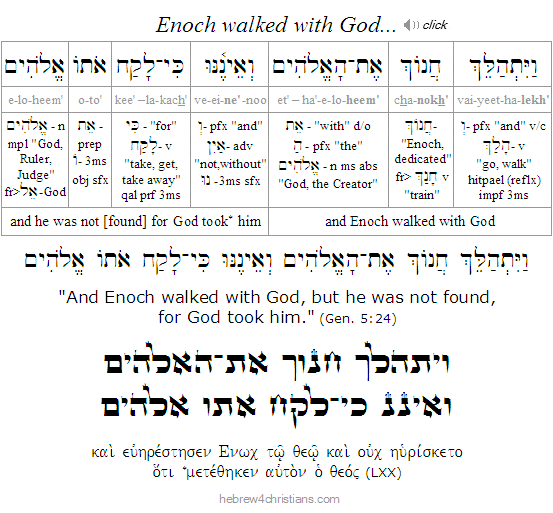 |
|
|






